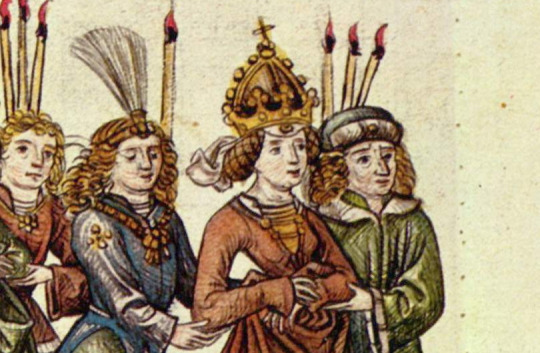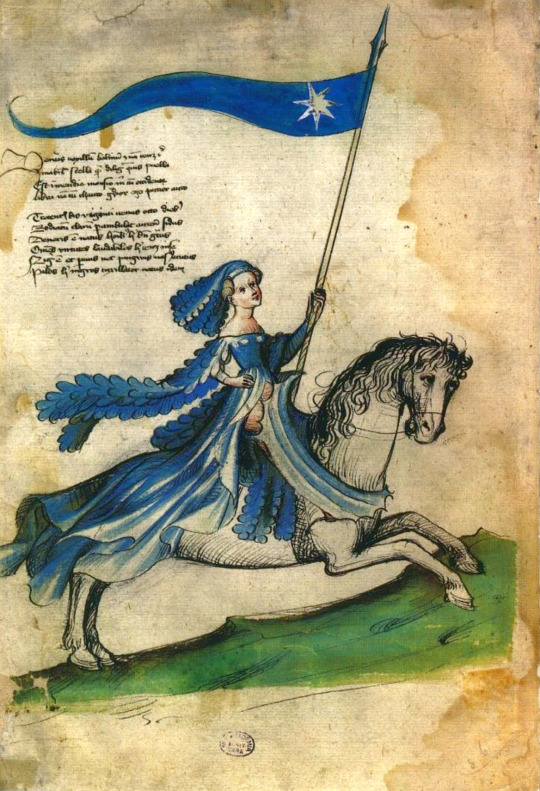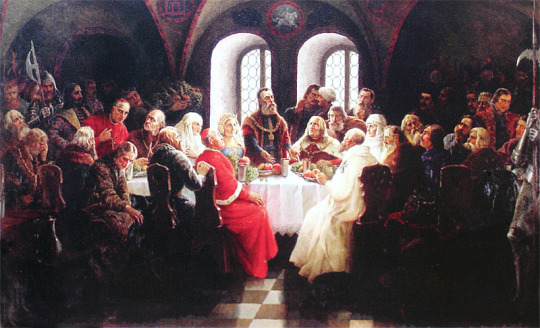#elisabeth piast
Explore tagged Tumblr posts
Photo


Angevin Queens of Hungary 3/6:
Elizabeth of Poland, Queen of Hungary (c.1305-29 December 1380)
Elizabeth of Poland was the second of two surviving daughters of King Wladyslaw I of Poland and Jadwiga of Greater Poland. Her older sister was Kunigunde, who became Duchess of Swidnica and Duchess of Saxe-Wittenberg by her two marriages. Her only surviving brother was King Casimir III of Poland.
She was probably born between 1300 and 1305. Both of Elizabeth’s parents were members of Poland’s royal Piast dynasty. Her father Wladyslaw, was from the Masovian-Kuyavian branch, and her mother was from the Greater Poland branch. At the time of her birth, Poland was divided into multiple provinces. Wladyslaw spent years reuniting the country, and was finally crowned King of Poland in 1320.
That same year, the twice-widowed, but childless King Charles I of Hungary was looking for a new wife so he could continue his new dynasty. Wanting to make an alliance with the new Polish King, Elizabeth, the only unmarried daughter, was a good candidate. Elizabeth and Charles married on 6 July 1320, when she was about fifteen or a little older. This marriage started a long period of corporation between Poland and Hungary, especially in trade and politics.
Elizabeth gave birth to a son named Charles in 1321, but unfortunately he died the same year. However, a few years later, she bore three more sons in quick succession; Ladislaus in 1324, Louis in 1326, and Andrew in 1327. The oldest, Ladislaus died in 1329, making Louis his father’s heir. Elizabeth’s next known child, Stephen wasn’t born until December 1332.
On 17 April 1330, Elizabeth, King Charles, and their two sons, Louis, four and Andrew, two, where dining at their castle of Visegrad, when Felician Zah, a Hungarian nobleman stormed in and attacked the royal family in an assassination attempt. Elizabeth, apparently trying to protect her sons, lost four fingers on her right hand in the attack and the king was wounded in the arm. The two young boys seem to have been unharmed. Immediately, the guards killed Zah on the spot. Charles took brutal revenge on Zah’s family. The exact reasons for the assassination attempt are unclear. Usually it is said that Elizabeth’s brother Casimir, who visited the Hungarian court a month earlier, raped Zah’s daughter /Elizabeth’s lady-in-waiting, Klara Zah, and Felician Zah wanted revenge. However others think that the assassination attempt was part of a conspiracy of the Hungarian nobility to remove King Charles, who they considered an usurper.
It appears that Elizabeth did not let this incident affect her too much, for she became on of the most powerful queens of her era. She is believed to have introduced the first alcohol-based perfume to Europe, which to this day is known as “The Queen of Hungary’s Water”. During her husband’s lifetime, she started opening religious houses, something she would continue for the rest of her life. Many of the churches that opened in Hungary during her time were founded by Elizabeth and her son, Louis, who seems to have been greatly influenced by his mother. Elizabeth was not that politically active during her husband’s lifetime, but after his death in 1342, her influence greatly expanded.
Elizabeth’s second son Andrew, was married to Joanna, the heiress of Naples. He was expected to rule Naples with his wife. King Charles of Hungary had this marriage arranged because his own claim to Naples was stronger according to primogeniture. Joanna’s grandfather, King Robert of Naples died in 1343, and in his will he bequeathed Naples entirely to Joanna, and made no mention of Andrew. Pope Clement VI approved of this decision, and crowned Joanna as sole monarch of Naples. Andrew informed Elizabeth, and she made a visit to Naples. She was angry about her son’s exclusion and tried to bribe to pope into crowning him King of Naples. She also gave Andrew a ring that was believed to protect him from blade or poison. However, Andrew, never being crowned King was murdered in September 1345. Whether Queen Joanna took part in the murder is disputed, but Elizabeth and Louis believed that she was guilty, and were determined to avenge Andrew’s death.
Elizabeth was very close to her son, King Louis I of Hungary, and played a prominent role in his court for most of his reign. Her brother Casimir had been King of Poland since 1333, and since he had no sons, he recognized Elizabeth and Louis as his possible heirs. Casimir died in 1370, leaving only daughters, and Louis became the new king of Poland, due to his mother’s linage. However he chose to remain in Hungary, and sent Elizabeth to Poland to be his regent there.
Her regency in her native country was disastrous. The Poles did not like being in union with Hungary. Elizabeth was unpopular in Poland during her regency, and she faced uprisings. Apparently, she forced heavy taxes on her subjects, who hated paying them. In December 1376, a brawl broke out between the Poles and Hungarians, who Elizabeth had brought with her. About 160 Hungarians were killed in the fight. Fleeing for her life, Elizabeth returned to Hungary.
Elizabeth spent her final years in a monastery outside of Buda, but still took a small part in politics, such as securing her granddaughter’s rights to the thrones of Hungary and Poland (Louis had no sons). This formidable queen died on 29 December, 1380, well into her seventies. She was buried in one of the monasteries which she founded. King Louis, her only child alive at the time of her death outlived her by less than two years.
#capetian house of anjou#angevin#angevin dynasty#piast#piast dynasty#angevin queens of hungary#queens of hungary#14th century#elizabeth of poland#elisabeth of poland#elizabeth piast#elisabeth piast#elzbieta piast#elżbieta Łokietkówna#medieval queens#history edit#polish princesses
38 notes
·
View notes
Photo


Barbara of Celje (also Barbara of Cilli) was (most likely) born in 1392 as the 5th and youngest child of count Hermann II of Celje and countess Anna of Schaunberg. Through her marriage to Sigismund of Luxembourg, which (probably) occured in 1405, she was Queen of Hungary (1405), Queen of the Romans (1411), Queen of Bohemia (1419) and Holy Roman Empress (1433).
The Counts of Celje were a prominent late medieval family, rising from the position of mere vassals to the Habsburgs (with whom they were often in conflict) to Princes of the Holy Roman Empire subordinate only to the Emperor in a relatively short time span, owing mainly to the political ability and military prowess of Barbara’s father Hermann. By saving the life of Sigismund of Luxembourg not once, but twice (first in the Battle of Nicopolis against the Ottomans in 1396 and then again when he was kidnapped by the Hungarian nobility in 1401), Hermann ensured his youngest daughter Sigismund’s hand in marriage. The Celje family was a good choice for Sigismund as well, since they were contenders for the Bosnian throne (and they eventually became heirs presumptive in 1427), had good connections in the Balkans (Hermann’s eldest son Frederick was married to Elisabeth of Frankopan, Frankopans being the most influential family in the region at the time), but also because Barbara’s cousin Anna of Celje was the new Polish queen (by marrying her – the granddaughter of Casimir III who was the last Polish king of the Piast dynasty – Vladislaus II Jagiellon solidified his rule after the death of his wife Jadwiga, queen regnant of Poland).

Queen Barbara herself was an important figure, serving as regent when Sigismund was absent and she was a capable manager of her own fiefdoms. Alongside her husband, she appeared at the Council of Constance (1414-1418) (the two pictures at the top {x} {x}), which ended the Western Schism, and the Congress of Lutsk (1429) (the picture above {x}, Sigismund can be seen standing in the centre with Barbara sitting on his right). She was instrumental in creating the Order of the Dragon (1408), whose most notable member is probably Vlad III Dracul or Vlad the Impaler. She was the only woman named in the founding document and the only woman to be its member (by virtue of being its founder).
Barbara was, however, not paticularly popular among many nobles who thought she was too sympathetic to the cause of the Hussites (it should be noted that she is also often considered in modern examinations of agnosticism and atheism in medieval times) and they accused her of adultery, which led to a strain in her marriage with Sigismund. She was dubbed “the Messalina of Germany” by Aeneas Sylvius Piccolomini, who went on to become Pope Pius II years later. It didn’t help that she was a knowledgeable woman and an alchemist, which earned her the epithet “Black Queen” among the common folk.
Toward the end of Sigismund’s reign she conspired against her son-in-law Albert II of Germany (a Habsburg by birth, married to her only child, Elisabeth of Luxembourg), supposedly so that in the event of Sigismund’s death, the future Polish king Casimir IV would inherit his titles instead of Albert, as well as take her as his wife – the latter might have been a made-up exaggeration, more likely she merely made plans for her granddaughters: one would indeed marry Casimir (which did eventually happen when Elisabeth of Austria married him), while the other would marry his brother Vladislaus III, who was king before him. But the plot was revealed, to the great ire of Barbara’s husband, who banished her to the castle in Znojmo. After Sigismund’s death the same year in 1437, when she lost all the titles that came along with the marriage, she left for Poland and only returned to Bohemia in 1441, two years after her arch-rival Albert died. She spent the last 10 years of her life in Mělník, protected by her loyal Bohemian nobles, notably George of Poděbrady, supporting the political advances of her daughter Elisabeth of Luxembourg and, after the latter’s death, her grandson Ladislaus V the Posthumous.
She died of the plague in 1451. She is buried in the Royal Crypt in St. Vitus Cathedral in Prague. Even though she only ever bore one daughter, Barbara of Celje is the ancestress of most, if not all European royal houses that lived in the following centuries.
#as far as n*bles go she was quite ok#slovenia#slovene people#*insomuch as people at that time were slovene#barbara of celje#barbara of cilli#counts of celje#counts of cilli#celje
208 notes
·
View notes